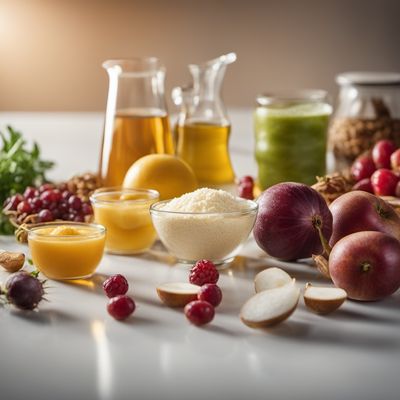
Ingredient
Raising agents
The Magic Behind Culinary Rise: Unveiling the Secrets of Raising Agents
Raising agents are substances used in baking to create aeration and volume in doughs and batters. They work by releasing gases, such as carbon dioxide, which expand when heated, causing the mixture to rise. Raising agents can be categorized into three types: biological (yeast), chemical (baking powder, baking soda), and physical (whipped egg whites). Each type has its own unique characteristics, taste, texture, and appearance. Biological raising agents, like yeast, provide a distinct flavor and a chewy texture, while chemical raising agents, such as baking powder, yield a more neutral taste and a light, airy texture. Physical raising agents, like whipped egg whites, contribute to a fluffy and delicate texture. The choice of raising agent depends on the desired outcome of the recipe and the specific characteristics one wishes to achieve.
Origins and history
The use of raising agents in baking can be traced back to ancient civilizations. Egyptians were among the first to discover the leavening properties of yeast, using it to ferment dough and create bread. In the 19th century, the development of chemical raising agents, such as baking powder, revolutionized baking by providing a more convenient and reliable method for achieving leavening. Today, raising agents are widely used in various cuisines around the world, with each culture incorporating them into their traditional recipes.
Nutritional information
Raising agents are low in calories and do not significantly contribute to the nutritional content of baked goods. However, they play a crucial role in creating light and airy textures, enhancing the overall eating experience.
Allergens
Raising agents do not typically contain allergens. However, it is important to check the specific brand or product for any potential allergen cross-contamination.
How to select
When selecting raising agents, it is important to check the expiration date to ensure their effectiveness. For chemical raising agents, look for brands that use aluminum-free baking powder for a more neutral taste. Additionally, consider the specific requirements of your recipe, as different raising agents may yield different results.
Storage recommendations
Raising agents should be stored in a cool, dry place, away from moisture and strong odors. Properly sealed containers or airtight bags can help maintain their freshness and effectiveness.
How to produce
Raising agents are typically produced on an industrial scale and are not commonly produced at home. However, amateur bakers can create their own biological raising agent by cultivating a sourdough starter or making their own yeast from scratch.
Preparation tips
When using raising agents, it is important to follow the recipe instructions carefully, as the amount and type of raising agent can greatly affect the outcome of the baked goods. For chemical raising agents, it is crucial to mix them with the dry ingredients before adding any liquids to ensure even distribution. When using biological raising agents, such as yeast, it is important to activate them properly by proofing in warm water or milk before incorporating them into the dough. Additionally, avoid overmixing the batter or dough once the raising agent has been added to prevent deflation.
Culinary uses
Raising agents are essential in a wide range of baked goods, including cakes, muffins, bread, pancakes, and pastries. They are also used in some savory dishes, such as Yorkshire pudding and soufflés, to achieve a light and airy texture.
Availability
Raising agents are widely available in grocery stores, supermarkets, and baking supply stores worldwide.
More ingredients from this category » Browse all

Antioxidant
"Nature's Defense: Unleashing the Power of Antioxidants"

Bulking agent
The Secret to Fluffy Delights: Bulking Agent

Acid
The Tangy Elixir: Unleashing the Power of Acidity in Culinary Delights

Gelling agent
The Magic of Gelling Agents

Firming agent
The Secret Ingredient for Perfect Texture

Propellent gas
The Power Behind the Spray: Unveiling the Secrets of Propellent Gas

Anti-caking agent
The Secret Ingredient: Unveiling the Magic of Anti-Caking Agents

Thickener
The Art of Creating Perfectly Thickened Delights

Flavour enhancer
The Magic of Umami

Emulsifier
The Harmony Enhancer

Acidity regulator
The Balancing Act: Understanding Acidity Regulators

Stabiliser
The Secret Ingredient for Perfect Texture